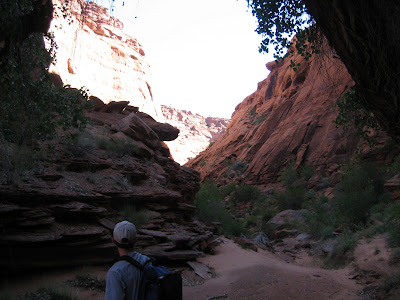
 The first stage in this direction (up & out) is the hike and climb through the main canyon bottom- what I call the Underworld- and up and out a navigable side canyon. This is basically more of what you’ve been dayhiking the last few days- beautiful, with high walls and a small patch of sky overhead, easy navigation.
The first stage in this direction (up & out) is the hike and climb through the main canyon bottom- what I call the Underworld- and up and out a navigable side canyon. This is basically more of what you’ve been dayhiking the last few days- beautiful, with high walls and a small patch of sky overhead, easy navigation.
 The second stage is the Middleworld. The Middleworld is a weird land of interconnected sandstone hills, ramps, cliffs and ledges interspersed with ravines and patches of brush and woodland. The Middleworld is far and away the most problematic stage navigationally- suddenly a ramp starts rolling steeper and turns to a wall, or a little valley winds its way into a dead end, or open out into a towering pour-off. For many of us, the Middleworld is the closest we come to navigating a maze in the natural world.
The second stage is the Middleworld. The Middleworld is a weird land of interconnected sandstone hills, ramps, cliffs and ledges interspersed with ravines and patches of brush and woodland. The Middleworld is far and away the most problematic stage navigationally- suddenly a ramp starts rolling steeper and turns to a wall, or a little valley winds its way into a dead end, or open out into a towering pour-off. For many of us, the Middleworld is the closest we come to navigating a maze in the natural world.
 The third stage is the Overworld, the high plateau surrounding the canyon, over which you trudge back to your vehicle, (which hopefully will still be present, intact and operational.) And the shocking thing about the Overworld is the sky. So much sky, all around you. Too much sky, no protective canyon walls, and so much light. You tuck down your cap visor a bit, and focus on the ground ahead, but all that sky and light is both wonderful and un-nerving at the same time.
The third stage is the Overworld, the high plateau surrounding the canyon, over which you trudge back to your vehicle, (which hopefully will still be present, intact and operational.) And the shocking thing about the Overworld is the sky. So much sky, all around you. Too much sky, no protective canyon walls, and so much light. You tuck down your cap visor a bit, and focus on the ground ahead, but all that sky and light is both wonderful and un-nerving at the same time.
 The second plant is fascinating because its so different from everything else around it: Mormon Tea, Ephedra viridis (Green Mormon Tea) or Ephedra nevadensis (Nevada Mormon Tea.) (The two species overlap and are tricky to tell apart.). Ephedra is a genus of several dozen species, around 10(?) of which are native to
The second plant is fascinating because its so different from everything else around it: Mormon Tea, Ephedra viridis (Green Mormon Tea) or Ephedra nevadensis (Nevada Mormon Tea.) (The two species overlap and are tricky to tell apart.). Ephedra is a genus of several dozen species, around 10(?) of which are native to
 Gnetophytes are way ancient (200+ million years) have never been very numerous, but hang on in specialized niches. Ephedra is one of 3 families in the order (the other 2 are totally weirdsville). Ephedra bears no leaves, only stems, which are green, upright and fairly flexible, and it is within the stems that photosynthesis takes places. Ephedra is dioecious, and the male cones “bloom” in April and May like little flowers (which they are not.) Ephedra is what I call a “Wind-Agent” plant, meaning it is wind-pollinated, but its seeds dispersed by an external agent- usually small rodents who cache them underground. Ephedra also reproduces asexually, via root cloning, and often re-sprouts from the crown following fire.
Gnetophytes are way ancient (200+ million years) have never been very numerous, but hang on in specialized niches. Ephedra is one of 3 families in the order (the other 2 are totally weirdsville). Ephedra bears no leaves, only stems, which are green, upright and fairly flexible, and it is within the stems that photosynthesis takes places. Ephedra is dioecious, and the male cones “bloom” in April and May like little flowers (which they are not.) Ephedra is what I call a “Wind-Agent” plant, meaning it is wind-pollinated, but its seeds dispersed by an external agent- usually small rodents who cache them underground. Ephedra also reproduces asexually, via root cloning, and often re-sprouts from the crown following fire.
 There are a couple of other interesting things about Ephedra. The first is that the form of the male cones is such that they direct wind currents to disperse its pollen away from itself- a more sophisticated dispersal schema than the undirected "pollen blast" of conifers. The other is that Ephedra is the only known non-Angiosperm to practice double fertilization, a sophisticated reproductive mechanism we'll look at when we talk about Oak.
There are a couple of other interesting things about Ephedra. The first is that the form of the male cones is such that they direct wind currents to disperse its pollen away from itself- a more sophisticated dispersal schema than the undirected "pollen blast" of conifers. The other is that Ephedra is the only known non-Angiosperm to practice double fertilization, a sophisticated reproductive mechanism we'll look at when we talk about Oak.
No comments:
Post a Comment